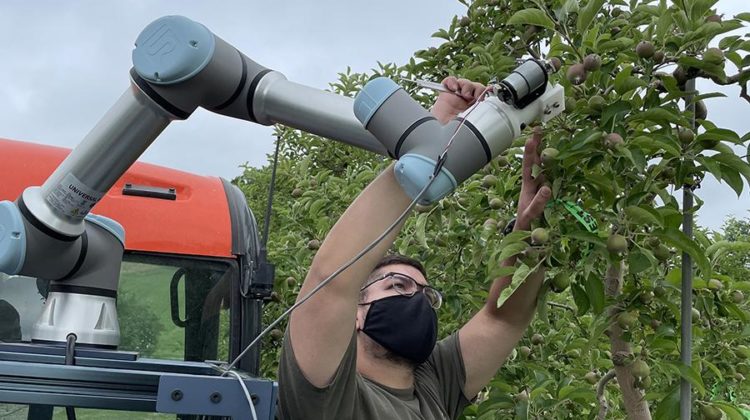
A team of Pennsylvania State University agricultural engineers has developed the first ever prototype ‘end-effector’ capable of removing unwanted apples from trees – the first step towards robotic, green-fruit thinning.
Green-fruit thinning – the process of discarding excess fruitlets in early summer, mainly to increase the remaining fruit size and quality – is one of the most important aspects of apple production. However, manual thinning is a labour-intensive task and the shrinking labour force in apple production is increasingly making manual thinning economically unfeasible.
‘In the next decade, we hope, this end effector will be combined with a machine-vision component and a locomotion system, creating a mechanism that eventually will be able to accomplish robotic green-fruit thinning in apple orchards,’ said Long He, an assistant professor of agricultural and biological engineering in the College of Agricultural Sciences. ‘I realise that this sounds wildly futuristic, but I think this is where we are headed, sooner than later, and this end-effector was the needed first step.’
Prior to designing the end-effector, lead researcher Magni Hussain, a doctoral-degree student in the Department of Agricultural and Biological Engineering, performed a series of fruit-removal-dynamics tests to determine the forces required for robotic thinning, using pulling or stem-cutting methods on three different apple cultivars.
After finding that fruit removal using the pulling method resulted in a high occurrence of spur-end stem detachment, which can leave a wound that affects neighbouring fruits in a cluster, Hussain built a stem-cutting end-effector prototype and conducted extensive field tests. He tested two end-effector prototype configurations: one placing the end-effector on a handheld bar; the other integrating the end-effector with a robotic manipulator.
The success rates of green-fruit removal for all end-effector-prototype experiments exceeded 90 per cent. Linking the end-effector with a robotic manipulator demonstrated the potential of a robotic green-fruit system to remove fruit at different locations and orientations. Robotic green-fruit thinning can potentially be as selective as manual thinning, the researchers suggested.
Hussain and He are already looking to the next stage of the research. The former is now working on the machine-vision component of the overall robotic system, ‘trying to design it from the ground up, so to speak’, he said. The challenge is significant, he conceded, because for such a vision system to work, there are several components to consider.
‘First and foremost, it has to detect green fruit, and I’ve implemented a deep-learning algorithm into the system to enable it to not only detect the green fruit in a tree environment, but also generate their pixel masks,’ Hussain said. ‘And then, on top of detecting the fruit, I’m also inserting an algorithm that will allow it to detect the orientation of the fruit. Because when you’re trying to remove green fruit, knowing their orientations is important for properly orienting an end-effector for fruit removal.’
The research has been published in the Journal of the American Society of Agricultural and Biological Engineers.


